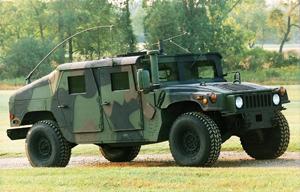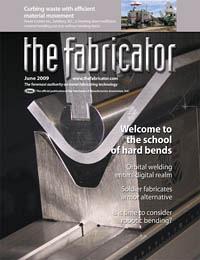Editor-in-Chief
- FMA
- The Fabricator
- FABTECH
- Canadian Metalworking
Categories
- Additive Manufacturing
- Aluminum Welding
- Arc Welding
- Assembly and Joining
- Automation and Robotics
- Bending and Forming
- Consumables
- Cutting and Weld Prep
- Electric Vehicles
- En Español
- Finishing
- Hydroforming
- Laser Cutting
- Laser Welding
- Machining
- Manufacturing Software
- Materials Handling
- Metals/Materials
- Oxyfuel Cutting
- Plasma Cutting
- Power Tools
- Punching and Other Holemaking
- Roll Forming
- Safety
- Sawing
- Shearing
- Shop Management
- Testing and Measuring
- Tube and Pipe Fabrication
- Tube and Pipe Production
- Waterjet Cutting
Industry Directory
Webcasts
Podcasts
FAB 40
Advertise
Subscribe
Account Login
Search
Armored and ready to make a difference
Iraq veteran is both a fabricator and an inventor of lighter-weight armor
- By Dan Davis
- June 2, 2009
- Article
- Manufacturing Software

Figure 1Typical HUMVEEs sent to war zones before Iraqi Freedom did not come with additional armor, which is much needed today.
Doug Bergeson is a proud Army National Guard veteran, no Marine, but he has shown the same type of versatility that a certain celluloid leatherneck asked of his guys. He is also owner and founder of the metal fabricating company Bergeson Technology Inc., Dawson, Minn.
Bergeson found he had to adapt, overcome, and improvise during his 16-month stay in the hottest of hot spots in Iraq from February 2006 to July 2007. His resourceful actions then have now put him in a situation where he thinks he can help soldiers who are following in his footsteps in Iraq and who are engaged in other military encounters around the world.
He Adapted
You see, Bergeson is not new to metal fabricating. He has more than 20 years of experience working with metal and plastics. Some of that time was spent working in production environments, but he also enjoyed time fabricating prototypes in R&D settings. The latter experience provided him with a great foundation for creative thought and developing a deep reservoir of manufacturing knowledge.
But he wasn't in Iraq as a fabricator. His exact title was brigade ammunition manager for the 34th Infantry Div., stationed in Rosemount, Minn. He was in charge of supplying, storing, and monitoring ammo for his fellow "Red Bulls" in his division—from the front line and back to the base.
Even with a different job description from his civilian life, Bergeson realized his real-world skills might be able to make a difference in his other-side-of-the-world danger zone. He had a front-row seat to the damage that was being inflicted upon unprotected military vehicles (see Figure 1).
Iraqi insurgents had adopted improvised explosive devices as one of their main weapons against U.S. troops, and ground vehicles for U.S. troops were poorly suited to provide the maximum amount of protection for those inside. Of particular worry were explosive-formed projectiles (see Figure 2) that could be used for more precise attacks and posed a great risk to the lives of targeted troops.
The "up-armor" efforts started almost as soon as U.S. troops knew they were vulnerable. In the early days of Operation Iraqi Freedom, troops tried to attach as much plate as possible to vehicles to create crude armor packages. Back in the U.S., more formal "kits" were fabricated and sent to Iraq for installation or installed on vehicles destined to be shipped to Iraq.
During his off-hours—never while on duty—Bergeson began experimenting with developing his own armored panel. Grabbing whatever steel and plastic scraps he could from the garage or the scrap pile, he forged ahead. While others were watching movies or shooting pool, Bergeson was drawing and designing.
He Overcame
"Today they use metals, metals, and more metals [for the armor kits]," said Allen Nelson, Bergeson Technology's general manager and a Vietnam War veteran.
That's just a recipe for disaster. The weight of the heavy armor puts an incredible strain on the vehicles' suspension system and shortens the vehicles' useful life by a great degree. In addition, when these armor add-ons are penetrated after an attack, the entire structure to which the armor is welded has to be replaced. The approach didn't make too much sense to Bergeson.
"I noticed that in Iraq, they were adding on things, such as more plate," he said. "That's what is unique about my armor invention. It's lighter. That's what sparks everyone's interest."
Bergeson returned to the U.S. in mid-2007, and he had a prototype armor kit made only months later.
His patented approach eschews plate and more plate. It relies on individual panels, with each panel comprising common carbon steel encapsulated in a mixture of plastic made from phenolic and urethane resins (see Figure 3).
vThe panels slip into a holder that is configured for the vehicle. When a panel has been penetrated, the service personnel loosen the crossbar over the holder with a hand tool, remove the damaged panel, and replace it with a substitute.Bergeson said the panels can be fabricated to any size, making it an armor alternative for any section of a military vehicle. Even angled sides can be covered with an overlap design; no exposed straight seam would be detectable, according to Nelson.
"The so-called 'new approach' now is they're using metal and ceramic," Nelson said. "Ceramic's fine. But you take one hit, and you've got nothing but dust.
"We do not use ceramic. We have a totally different concept on ours that nobody else is even looking at. But it required Doug's past experience with metal fabrication to come up with this," he continued.
He Improvised
The armor panels can be made for less money because they rely on common materials. The armor panels can be relied upon to protect soldiers based on extensive testing Bergeson conducted when he returned to the U.S. The armor panels weigh less than competing armor kit technology; a Bergeson-designed panel weighs almost one-third less and is 2 inches thinner than a 12-in.-wide by 12-in.-tall by 11.5-in.-deep all-plate panel typically used for testing. So what's keeping the government from even considering the armor alternative? Well, it's the government.
Nelson said he has spoken with local government representatives, who have listened but not promised anything. Additionally, Bergeson Technology doesn't have the "government stamp of approval," according to Nelson, so compliance with federal rules for vendors is an issue. Getting the notice of military or government personnel hasn't been an easy chore.
"Yeah, it's frustrating," Bergeson said.
As the company tries to get the word out on the panels, Bergeson has turned to what he knows best. He's opened a full-fledged metal fabricating shop.
The company has a 30-ton turret punch (see Figure 4) and a 10-ft., 90-ton press brake, both of which have CNCs. The shop also has the capability to drill, machine, saw, shear, and weld parts, as well as the means to design fabrications (see "A Big Upgrade in Design Tools" sidebar).
The shop has won enough business to keep the other two full-time and two part-time employees busy making parts (see Figure 5), but it is still looking for the right contact to help expose the armor panels to the right eyes in the government.
For Bergeson, manufacturing the panels is not an excellent business opportunity. It's an effort to "protect our military heroes and save the lives of our sons and daughters," according to Bergeson.
A movie script couldn't have said it any better.
A Big Upgrade in Design Tools
Trying to design an armored panel in the midst of a war-ravaged country is not the easiest task.
"[I was] drawing on a piece of paper," said Doug Bergeson, metal fabricator and Operation Iraqi Freedom veteran. "I went back to the Stone Age, working with a file and a hack saw. Many times I wish I had my shop back in Minnesota."
Bergeson got pulled into the Information Age when he upgraded his software tools once he got back to the U.S. He jumped from an early version of SmartCAM to the latest, version 15.
He can now quickly produce a job plan detailing production steps for the shop floor operators right from a CAD file, and Bergeson's shop now can accommodate DXF file formats. Also, Bergeson said he has newfound design creativity in that he can draw in a freehand mode or he can import shapes and use tools to accentuate them.
"It's just a sweet deal," he said.
After trying to fabricate parts in a war zone, he truly can appreciate modern manufacturing tools.
About the Author

Dan Davis
2135 Point Blvd.
Elgin, IL 60123
815-227-8281
Dan Davis is editor-in-chief of The Fabricator, the industry's most widely circulated metal fabricating magazine, and its sister publications, The Tube & Pipe Journal and The Welder. He has been with the publications since April 2002.
Related Companies
subscribe now

The Fabricator is North America's leading magazine for the metal forming and fabricating industry. The magazine delivers the news, technical articles, and case histories that enable fabricators to do their jobs more efficiently. The Fabricator has served the industry since 1970.
start your free subscription- Stay connected from anywhere

Easily access valuable industry resources now with full access to the digital edition of The Fabricator.

Easily access valuable industry resources now with full access to the digital edition of The Welder.

Easily access valuable industry resources now with full access to the digital edition of The Tube and Pipe Journal.
- Podcasting
- Podcast:
- The Fabricator Podcast
- Published:
- 04/16/2024
- Running Time:
- 63:29
In this episode of The Fabricator Podcast, Caleb Chamberlain, co-founder and CEO of OSH Cut, discusses his company’s...
- Industry Events
16th Annual Safety Conference
- April 30 - May 1, 2024
- Elgin,
Pipe and Tube Conference
- May 21 - 22, 2024
- Omaha, NE
World-Class Roll Forming Workshop
- June 5 - 6, 2024
- Louisville, KY
Advanced Laser Application Workshop
- June 25 - 27, 2024
- Novi, MI































